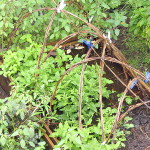Search
Latest topics
» Cooked worms?by KiwiSFGnewbie Yesterday at 11:18 pm
» What are you eating from your garden today?
by cyclonegardener Yesterday at 10:35 pm
» N & C Midwest: Nov. Dec. 2024
by OhioGardener Yesterday at 5:06 pm
» Tree roots, yeeessss.....
by KiwiSFGnewbie Yesterday at 12:17 am
» New SFG gardener in Auckland
by KiwiSFGnewbie 11/16/2024, 11:25 pm
» Kiwi's SFG Adventure
by KiwiSFGnewbie 11/12/2024, 7:10 pm
» Thanksgiving Cactus
by OhioGardener 11/12/2024, 5:40 pm
» Happy Birthday!!
by sanderson 11/11/2024, 11:57 am
» Need Garden Layout Feedback
by markqz 11/9/2024, 9:16 pm
» Thai Basil
by Scorpio Rising 11/8/2024, 8:52 pm
» How best to keep a fallow SFG bed
by KiwiSFGnewbie 11/8/2024, 8:11 pm
» Preserving A Bumper Tomato Harvest with Freezing vs Canning
by plantoid 11/7/2024, 11:36 am
» Mark's first SFG
by sanderson 11/6/2024, 11:51 pm
» What Have You Picked From Your Garden Today
by OhioGardener 11/5/2024, 2:29 pm
» Greetings from Southeastern Wisconsin
by sanderson 11/5/2024, 2:01 pm
» Spinning Compost Bin-need some ideas
by rtfm 11/2/2024, 7:49 pm
» Growing fruit trees in Auckland
by OhioGardener 10/31/2024, 4:23 pm
» Vermiculite -- shipping sale through 10/31/2024
by markqz 10/30/2024, 2:27 pm
» N & C Midwest: October 2024
by Scorpio Rising 10/30/2024, 10:38 am
» Old Mulch and Closing Beds for Winter
by sanderson 10/26/2024, 11:00 pm
» Ohio Gardener's Greenhouse
by OhioGardener 10/25/2024, 7:17 pm
» Hello from Land of Umpqua, Oregon Zone 8b
by sanderson 10/25/2024, 3:14 pm
» Hello everyone!
by SFGHQSTAFF 10/24/2024, 3:22 pm
» Senior Gardeners
by sanderson 10/23/2024, 6:09 pm
» Hello from South Florida
by markqz 10/23/2024, 10:30 am
» Confirm what this is
by sanderson 10/11/2024, 2:51 pm
» Harlequin Beetles?
by sanderson 10/7/2024, 3:08 pm
» N & C Midwest: September 2024
by OhioGardener 9/30/2024, 4:13 pm
» The SFG Journey-Biowash
by OhioGardener 9/29/2024, 8:33 am
» Fall is For Garlic Planting
by Scorpio Rising 9/28/2024, 12:19 am
Google
Lactobacilli, a natural Fungicide
2 posters
Page 1 of 1
 Lactobacilli, a natural Fungicide
Lactobacilli, a natural Fungicide
How to make Lactobacilli, a natural Fungicide
Last edited by camprn on 5/26/2017, 12:07 pm; edited 1 time in total (Reason for editing : edited title)

has55- Posts : 2345
Join date : 2012-05-10
Location : Denton, tx
 Re: Lactobacilli, a natural Fungicide
Re: Lactobacilli, a natural Fungicide
A bit has been lost in the translation from the linked page to the page it uses as a reference:
http://theunconventionalfarmer.com/recipes/lactobacillus-serum/
I like the directions here ^ better...
The separation would be into "curds and whey" not "milk fats and lactose" - I think the use of the short-hand lacto for the bacteria was confused as shorthand for lactose. Whey does contain lactose - but the liquid is only about 5% lactose (this jumps to closer to 70% once dried - but still not 'just about pure', nor are the curds lactose-free.) The original article suggests giving the whey to cats, but many (adult) cats are lactose intolerant. For comparison milk is also around 4-5% lactose. Also, it's Bacillus subtilis, not Bacillus Subtitles. (Autocorrect doesn't science well!) And these references indicate that Bacillus subtiliis induces pore(stomata) closing rather than "allowing the pores on the plant leaves to open up, and stay open longer":
https://www.researchgate.net/publication/276500494_Bacillus_subtilis-regulation_of_stomatal_movement_and_instantaneous_water_use_efficiency_in_Vicia_faba
http://onlinelibrary.wiley.com/doi/10.1111/j.1365-313X.2012.05116.x/abstract
-- The closing of the pores helps prevent pathogens from entering via the pores (stomata), and can help the plants survive under drought conditions since they lose water through their pores when they are open.
I would be tempted to skip the rice step and use an active-culture yogurt to inoculate the milk because yogurt contains already contains mostly or just (it's brand dependent) Lactobacillus spp. On the other hand the native air-borne lactobacilli might be more compatible with plants than those chosen for their compatibility with humans/yogurt-making.
I was actually wondering just the other day if encouraging bacterial growth to compete with fungi is why/how milk spray help stop/prevent mildew on squash/cukes. A spray that already has lots of bacteria in it seems like it would be more effective than fresh milk.
Perhaps compost tea spraying also works, in part, by inoculating the leaves with a diverse culture of bacteria that can grow to exclude fungi.
http://theunconventionalfarmer.com/recipes/lactobacillus-serum/
I like the directions here ^ better...
The separation would be into "curds and whey" not "milk fats and lactose" - I think the use of the short-hand lacto for the bacteria was confused as shorthand for lactose. Whey does contain lactose - but the liquid is only about 5% lactose (this jumps to closer to 70% once dried - but still not 'just about pure', nor are the curds lactose-free.) The original article suggests giving the whey to cats, but many (adult) cats are lactose intolerant. For comparison milk is also around 4-5% lactose. Also, it's Bacillus subtilis, not Bacillus Subtitles. (Autocorrect doesn't science well!) And these references indicate that Bacillus subtiliis induces pore(stomata) closing rather than "allowing the pores on the plant leaves to open up, and stay open longer":
https://www.researchgate.net/publication/276500494_Bacillus_subtilis-regulation_of_stomatal_movement_and_instantaneous_water_use_efficiency_in_Vicia_faba
http://onlinelibrary.wiley.com/doi/10.1111/j.1365-313X.2012.05116.x/abstract
-- The closing of the pores helps prevent pathogens from entering via the pores (stomata), and can help the plants survive under drought conditions since they lose water through their pores when they are open.
I would be tempted to skip the rice step and use an active-culture yogurt to inoculate the milk because yogurt contains already contains mostly or just (it's brand dependent) Lactobacillus spp. On the other hand the native air-borne lactobacilli might be more compatible with plants than those chosen for their compatibility with humans/yogurt-making.
I was actually wondering just the other day if encouraging bacterial growth to compete with fungi is why/how milk spray help stop/prevent mildew on squash/cukes. A spray that already has lots of bacteria in it seems like it would be more effective than fresh milk.
Perhaps compost tea spraying also works, in part, by inoculating the leaves with a diverse culture of bacteria that can grow to exclude fungi.

BeetlesPerSqFt-
 Posts : 1433
Posts : 1433
Join date : 2016-04-11
Location : Centre Hall, PA Zone 5b/6a LF:5/11-FF:10/10
 Re: Lactobacilli, a natural Fungicide
Re: Lactobacilli, a natural Fungicide
BeetlesPerSqFt-thank you for better clarification.

has55- Posts : 2345
Join date : 2012-05-10
Location : Denton, tx
 Similar topics
Similar topics» July 2012, New England
» Zonix - Organic - Alternative to Copper Fungicide for Late-Blight, Downey Mildew and Black Rot
» Never Again
» Beginning potatoes - Copper Fungicide??
» Soybean Rust! (Geeky Fungicide Question)
» Zonix - Organic - Alternative to Copper Fungicide for Late-Blight, Downey Mildew and Black Rot
» Never Again
» Beginning potatoes - Copper Fungicide??
» Soybean Rust! (Geeky Fungicide Question)
Page 1 of 1
Permissions in this forum:
You cannot reply to topics in this forum








